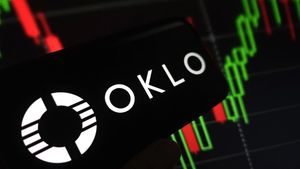
New York, NY – September 26, 2025 – The financial markets are buzzing today as the S&P 500 (NYSEARCA: VOO) experienced a notable uplift, reacting positively to the release of August's Personal Consumption Expenditures (PCE) price index. The report, a critical barometer for inflation and a key metric for the Federal Reserve, largely met economists' expectations, providing a much-needed sense of predictability in an otherwise volatile economic landscape. This "tame" inflation data has assuaged investor fears of more aggressive monetary tightening, fueling optimism for continued economic stability.
The immediate implication of this report is a palpable sigh of relief across trading floors. With inflation figures aligning with consensus forecasts, the narrative of a potential "soft landing" for the economy gains further traction. The S&P 500 (NYSEARCA: VOO), a broad measure of U.S. large-cap stocks, saw gains throughout the morning, signaling that investors are interpreting the data as supportive of a more measured approach from the Federal Reserve regarding interest rates.
A Closer Look at August's PCE Data and Market's Affirmative Nod
The August 2025 PCE report, released this morning, showed that while inflation persists above the Federal Reserve's long-term target of 2%, its trajectory remains within anticipated bounds. The headline PCE Price Index registered a 2.7% year-over-year increase, a marginal rise from July's 2.6%, yet perfectly in line with economists' predictions. On a month-over-month basis, the headline index rose by 0.3%, again mirroring consensus forecasts.
Crucially, the Core PCE Price Index, which strips out volatile food and energy prices and is the Federal Reserve's preferred measure for underlying inflation, held steady at 2.9% year-over-year in August, unchanged from July and precisely matching expectations. The month-over-month core PCE also increased by 0.2%, consistent with market predictions. These figures, while not indicating a rapid descent to the Fed's target, signify a predictable and stable inflation environment, alleviating concerns about runaway price pressures.
The timeline leading up to this moment has been characterized by a cautious market, closely scrutinizing every piece of economic data for clues on the Federal Reserve's next move. After a period of elevated inflation in previous years, the market has been highly sensitive to any signs of re-acceleration. This August PCE report, by confirming expectations, offers a reprieve from such anxieties. Key players involved in this economic narrative include the Federal Reserve, whose monetary policy decisions are heavily influenced by these reports, and various financial institutions and analysts who have been forecasting these trends. The initial market reaction was decisively positive, with S&P 500 futures climbing 0.15% pre-market, and the benchmark index extending those gains to 0.3% after the opening bell, demonstrating that investors "took the inflation data in stride."
Corporate Beneficiaries and Potential Headwinds in a Stable Inflation Environment
The implications of a tame and predictable inflation report ripple through various sectors of the economy, creating both winners and losers among public companies. Growth-oriented companies, particularly those in technology and consumer discretionary sectors, are poised to benefit significantly. Lower inflation reduces the likelihood of aggressive interest rate hikes, which in turn lowers borrowing costs and increases the present value of future earnings, a boon for high-growth firms. Companies like Apple (NASDAQ: AAPL), Amazon (NASDAQ: AMZN), and Tesla (NASDAQ: TSLA) could see increased investor confidence as their future growth prospects become more attractive in a stable rate environment.
Conversely, sectors that thrive on higher inflation or benefit from rising interest rates, such as certain financial institutions or commodity producers, might face headwinds. Banks, for instance, often see improved net interest margins when rates are rising rapidly. A stable or potentially declining rate environment, while good for the broader economy, could temper some of their profit expansion. However, the overall stability brought by tame inflation could also reduce loan defaults and stimulate economic activity, offering a different kind of benefit. Companies heavily reliant on stable consumer spending, like Walmart (NYSE: WMT) or Procter & Gamble (NYSE: PG), could also see consistent demand as consumer purchasing power is less eroded by unpredictable price surges.
Furthermore, companies with significant debt loads could also see an advantage. As the prospect of higher interest rates diminishes, the cost of servicing existing debt and securing new financing becomes more manageable. This could free up capital for investment, share buybacks, or dividend increases, ultimately boosting shareholder value. This environment generally favors companies with strong balance sheets that can capitalize on sustained economic growth without the drag of rapidly escalating input costs or financing expenses.
Broader Economic Implications and the Path Forward for Policy Makers
The latest tame inflation report is more than just a momentary market mover; it fits into a broader narrative of economic rebalancing and carries significant implications for industry trends, competitive landscapes, and regulatory policy. This moderation in price increases fosters a more predictable and stable economic environment, which is fundamentally conducive to long-term investment and sustained growth. Industries that rely heavily on consumer spending and long-term capital allocation, such as technology, renewable energy, and discretionary retail, are likely to experience tailwinds as businesses gain greater certainty in planning for the future.
This stability, however, creates a nuanced ripple effect across various market participants. While debt-reliant companies, like certain real estate investment trusts (REITs) or industrial firms, could see reduced financing costs, enhancing profitability, financial institutions might face compressed net interest margins if declining inflation leads to more aggressive interest rate cuts. Export-oriented businesses could find their goods more competitively priced globally, boosting international demand. Yet, even with "tame" inflation, businesses reliant on specific raw materials or complex international supply chains might still grapple with elevated input costs if global trends or tariffs remain problematic, forcing them to absorb costs or pass them on to consumers.
For the Federal Reserve, this report is a critical piece of the puzzle in navigating its dual mandate of achieving maximum sustainable employment and maintaining price stability. While the August PCE figures indicate inflation remains above the 2% target, their alignment with expectations strengthens the case for continued interest rate cuts. The Fed has been in an easing cycle through late 2024 and 2025, primarily citing a softening labor market. A tame inflation report provides further justification for this accommodative stance, aiming to stimulate economic growth and support employment. Historically, periods of successful disinflation often begin with core inflation trending downwards but still above target, with central banks carefully managing expectations and policy adjustments, much like the post-Great Inflation era where the Fed worked to maintain low and stable inflation. The challenge for the Fed will be to continue easing without reigniting inflationary pressures, a delicate balancing act that underscores the importance of ongoing data vigilance.
The Road Ahead: Navigating a Post-Tame Inflation Landscape
The August 2025 PCE report, signaling tame inflation, sets the stage for a critical period for both businesses and investors, offering both opportunities and challenges as the economy navigates towards a potentially stable future. In the short term, market sentiment is likely to remain positive, with the in-line inflation data reducing immediate anxieties and stabilizing interest rate expectations. This could fuel a relief rally in equity markets, particularly as it provides the Federal Reserve with greater flexibility to continue its easing monetary policy, having already initiated rate cuts to mitigate labor market risks. Policymakers, however, will remain vigilant for any unexpected resurgence in inflation that could quickly reverse market sentiment.
Looking further out, a sustained period of tame and stable inflation could usher in a more predictable economic environment, encouraging long-term investment and potentially extending the current bull market. Projections suggest that major indices like the Dow Jones Industrial Average (NYSEARCA: DIA) could experience steady upward trends, driven by expanding corporate profits, easing monetary conditions, and improving macroeconomic fundamentals, with high-tech investments, especially in artificial intelligence, acting as significant catalysts. Businesses must adapt by maintaining nimble financial planning, diversifying supply chains to enhance resilience, and implementing strategic pricing to manage customer impact. Investors, meanwhile, may re-evaluate asset allocations, potentially increasing exposure to high-quality dividend stocks or longer-duration bonds, while still holding real assets as a hedge against unforeseen inflationary trends.
Market opportunities are likely to emerge in interest-rate-sensitive sectors such as real estate, utilities, and high-growth technology companies, all poised to benefit from stabilized interest rate expectations and potentially lower borrowing costs. Strong consumer demand in a stable, moderately inflationary environment could also favor consumer discretionary sectors. However, challenges persist. An unexpected uptick in inflation, perhaps due to geopolitical events or new supply chain disruptions, could rapidly shift market sentiment. The market may also grapple with increased volatility even with "normalization cuts," and the "good news is bad news" paradox could emerge if strong economic data leads to fears of delayed rate cuts. Potential scenarios range from the most optimistic "soft landing," where inflation moderates without a severe recession, to a less favorable "sticky inflation" or even "stagflationary pressures" if inflation remains stubborn while growth slows. The current report strongly leans towards the soft landing, but continuous vigilance is paramount.
Wrapping Up: A New Chapter of Market Optimism, Cautious Vigilance
Today's tame August PCE report marks a significant moment for the financial markets, solidifying expectations of a "soft landing" and providing the Federal Reserve with ample room to continue its accommodative monetary policy. The key takeaway is that predictability in inflation, even if still above target, has a profoundly calming effect on investors, leading to a broad market rally led by the S&P 500 (NYSEARCA: VOO). This stability is a boon for growth-oriented companies and those with significant debt, while also encouraging long-term investment across various sectors.
Moving forward, the market's trajectory will hinge on a delicate balance. Investors should watch closely for subsequent inflation reports and, crucially, the Federal Reserve's communications and actions in its upcoming meetings, particularly regarding the pace and extent of future interest rate adjustments. The labor market data will also remain a critical indicator, as the Fed's dual mandate requires a healthy balance between price stability and maximum employment. Any unforeseen geopolitical events or supply chain disruptions could quickly alter this optimistic outlook, demanding continuous strategic flexibility from all market participants.
In conclusion, while the path ahead may still present its share of bumps, the August PCE report has injected a renewed sense of confidence into the market, suggesting that the economy is steadily navigating towards a more stable and predictable environment. This period calls for a balanced investment approach, combining growth opportunities with defensive strategies, and an unwavering focus on economic fundamentals.
This content is intended for informational purposes only and is not financial advice





